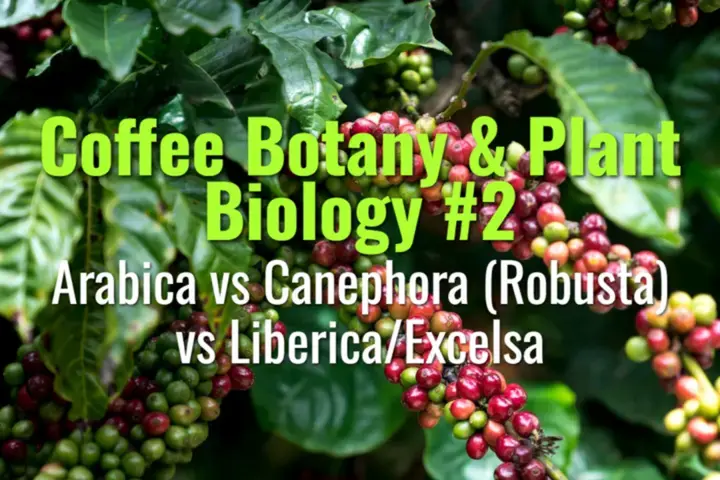Arabica vs Canephora (Robusta) vs Liberica/Excelsa
This topic compares the three main commercial coffee species—Arabica, Robusta (Canephora), and Liberica/Excelsa—covering their genetics, cultivation environments, bean traits, flavor profiles, and market roles.
- Coffee Basics Nerds
- 2 min read
Article 2 of 12 in Coffee Botany & Plant Biology/

1. Coffea arabica (Arabica)
- Genetics: Tetraploid (4 chromosome sets); hybrid of C. eugenioides × C. canephora.
- Growing conditions: Prefers high altitudes (1,000–2,200 m), cooler temperatures, and rich volcanic soils.
- Plant traits: Smaller, oval-shaped beans with a curved crease; delicate leaves and flowers.
- Flavor profile: Sweet, nuanced, aromatic with floral, fruity, or chocolate notes. Lower bitterness.
- Caffeine: 0.8–1.5% (lower than Robusta).
- Market role: ~60–70% of global production; core of specialty coffee.
- Weakness: Susceptible to pests (leaf rust, berry borer), lower yields.
2. Coffea canephora (Robusta)
- Genetics: Diploid (2 chromosome sets), more genetically diverse than Arabica.
- Growing conditions: Thrives in lowland tropics (<1,000 m), hot and humid climates, resistant to disease.
- Plant traits: Rounder, smaller beans with straighter crease; robust growth, larger root system.
- Flavor profile: Strong, bitter, earthy, often nutty or woody. Heavier body, less acidity.
- Caffeine: 1.8–2.7% (almost double Arabica), contributing to pest resistance.
- Market role: ~30–40% of production, dominant in instant coffee and espresso blends.
- Strength: High yield, resilient, cost-effective.
3. Coffea liberica
- Growing conditions: Lowland tropical climates, tolerant of heat and humidity.
- Plant traits: Very large leaves, fruits, and elongated beans.
- Flavor profile: Fruity, floral, smoky; polarizing for some drinkers.
- Caffeine: ~1.2–1.7%.
- Market role: <2% of global trade, but culturally significant in Southeast Asia (Philippines, Malaysia).
4. Coffea excelsa (a variety of Liberica)
- Classification: Once considered distinct, now reclassified under Liberica.
- Growing conditions: Similar to Liberica but found in Central Africa and Southeast Asia.
- Flavor profile: Tangy, tart, and complex with fruity brightness, often used in blends to enhance acidity.
- Market role: Very small-scale production, niche specialty interest.
Key Comparative Points
- Altitude preference: Arabica (high), Robusta (low), Liberica/Excelsa (low).
- Bean size: Arabica (medium, oval), Robusta (small, round), Liberica/Excelsa (very large, elongated).
- Flavor: Arabica (complex, smooth), Robusta (bitter, strong), Liberica (fruity/smoky, unique).
- Caffeine: Robusta highest, Arabica lowest, Liberica/Excelsa intermediate.
- Market dominance: Arabica and Robusta account for ~99% of trade; Liberica/Excelsa remain niche.
Lasting Importance
Each species contributes distinct strengths:
- Arabica for quality and complexity,
- Robusta for resilience, yield, and caffeine strength,
- Liberica/Excelsa for biodiversity and unique flavors.
Together, they shape the balance of global coffee production and represent vital options for adapting to climate change, pests, and evolving consumer tastes.
You might also like:
- Tags:
- Lasting Importance
- Specialty Coffee
- Flavor Profile
- Climate Change
- Coffee Production
- Instant Coffee
- Leaf Rust
- Global Coffee
- Arabica Robusta
- Lower Yields
- Heavier Body
- High Yield
- Floral Fruity
- Bean Size
- Berry Borer
- Liberica Excelsa
- Global Trade
- Cost Effective
- Volcanic Soils
- Fruity Floral
- Arabica Quality
- Smaller Beans
- Profile Strong
- Espresso Blends